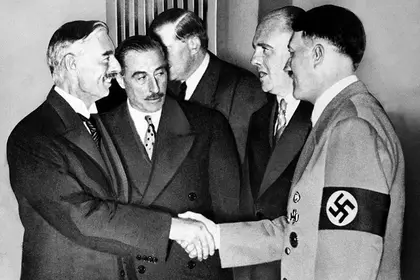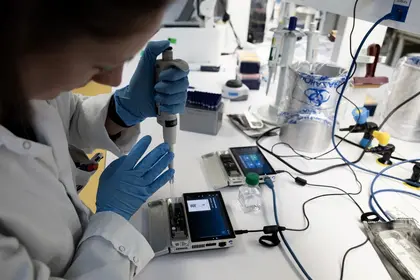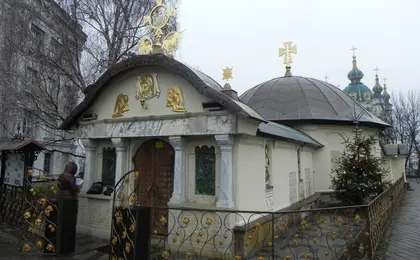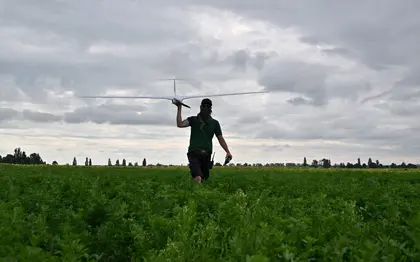Aug. 23, 1939
Soviet Foreign Minister Vyacheslav Molotov and Germany’s Foreign Minister Joachim von Ribbentrop sign the non-aggression treat in Moscow.

Soviet Foreign Minister Vyacheslav Molotov and Germany’s Foreign Minister Joachim von Ribbentrop sign the non-aggression treat in Moscow.
Sept. 1, 1939
Germany invaded Poland. Polish citizens of Ukrainian origin initially fought on Poland’s side. On Sept. 17, the Soviet Union launched its own invasion of Poland, occupying Halychyna and Volyn, which then belonged to Poland, and started mass repression against the local population. Ukrainians also fought on the side of the Soviet Union. The Soviets soon annexed Bessarabia and Northern Bukovyna, both then part of Romania.

Nazi German soldiers dismantle a Polish border gate.
June 22, 1941
Germany launched Operation Barbarossa, a full-scale invasion of the Soviet Union. Romania joined in the offensive, recovering Bessarabia and Northern Bukovyna. Retreating Soviet authorities conducted executions of 24,000 prisoners in Ukraine, including the murder of 1,681 prisoners in Lonckoho prison in Lviv.

A map of Operation Barbarossa, Nazi Germany’s attack on the Soviet Union, which was launched on June 22, 1941.
June 30, 1941
Relying on Germany’s support, the Organization of Ukrainian Nationalists under the leadership of Stepan Bandera proclaimed the Declaration of Ukrainian Independence in Nazi-occupied Lviv. Instead of support, the newly formed Ukrainian government was arrested and sent to concentration camps in Germany, part of Nazi repression of Ukrainians.
Sept. 19, 1941
After the 71-day Battle of Kyiv, Hitler’s Germany seized the Ukrainian capital. Prior to that, Nazi troops crossed the Dnipro River near Zaporizhzhia, Dnipropetrovsk, Kremenchuk and Cherkasy. Hundreds of thousands of soldiers of the Red Army were surrounded and captured. Others retreated to the east, destroying buildings and infrastructure to prevent their use by Nazis. Most historical buildings in downtown Kyiv were blown up by Soviets.

A guard of the fascist German Wehrmacht on the citadel of the previous day, the on Sept 19, 1941, conquered city of Kyiv and a view of the city with the burning Dnipro bridge.
Sept. 29, 1941
Nazis started mass executions of Jews, Roma, Ukrainian nationalists, Soviet activists, prisoners of war and others in Kyiv. During the Nazi occupation of Kyiv, up to 200,000 people were killed in Babyn Yar and the nearby Syrets concentration camp.

Soviet prisoners of war buried land plot of Babyn Yar, where were the Jews shot.
Dec. 18, 1942
Pivnivka in Luhansk Oblast became the first Ukrainian village liberated by the Red Army during the Soviet counter-offensive that began at the end of 1942. The Red Army soon started mass mobilization that included almost all males.

The Soviet liberation of Voroshilovgrad, now Luhansk on Feb. 14, 1943.
Feb. 17-21, 1943
The Organization of Ukrainian Nationalists under the leadership of Stepan Bandera decided to fight against the Nazis. The Ukrainian Insurgent Army, known as UPA, was founded on Oct. 14, 1942 and started its resistance activities in Nazi-occupied Volyn. Struggling for an independent Ukraine, UPA had to fight against three enemies at the same time: Nazis, Soviet army and partisans and the Polish Home Army, which considered parts of western Ukraine as belonging to Poland. UPA took part in the Ukrainian-Polish War that unfolded during World War II and took thousands of Ukrainian and Polish lives. UPA existed until the late 1950s, when it was defeated by Soviet authorities.

Organization of Ukraian Nationalists in Ostrog, Ukraine, in December 1943.
Aug. 23, 1943
The Soviet army liberated Stalino, now Donetsk, as part of a sweep through industrial areas that pushed the Nazis back to the Dnipro River.

Soviet troops move near the German sign for Stalino, the former name for Donetsk in Ukraine’s eastern Donbas region.
Sept. 8, 1943
The liberation of Kharkiv, the former capital of the Ukrainian Soviet Socialist Republic and Ukraine’s second largest city, marked the end of the Battle of Kursk. The city was heavily damaged. Along with victory near Stalingrad, this battle became a turning point in the Nazi-Soviet War.

Soviet tanks of the 5th Guard Tank Corps ride on Dzerzhinsky Square in Kharkiv on Feb. 16, 1943.
Nov. 6, 1943
Soviet troops liberated Kyiv after crossing the Dnipro River, after regaining the river cities of Zaporizhzhia and Dnipropetrovsk. The Battle for the Dnipro River became one of the largest and bloodiest military operations in history.

Soviet soldiers prepare rafts to cross the Dniprov River (the sign reads “To Kyiv!”) during the Battle of the Dnipro in 1943.
Feb. 2, 1944
Supported by the Red partisans, the Soviet army liberated Lutsk and Rivne as part of a broader offensive to free western Ukrainian cities.

Units of the 1st Cavalry Red Guards Corps enter in Lutsk on Feb 2, 1944.
April 10, 1944
The liberation of Odesa marked the end of the operation during which other south Ukrainian cities such as Kherson and Mykolaiv were freed.

May 9, 1944
After five-day storm and fierce fighting on Sapun Hill, the military port city of Sevastopol was liberated. Within days, Soviet authorities took control of the entire Crimean penisula and soon began deportation of more than 180,000 Crimean Tatars to other Soviet republics for alleged collaboration with the enemy. Among Crimean citizens deported there were also Greeks, Bulgarians, Gagauzes and others.

Soviet soldiers salute in honor of the liberation of Sevastopol in May 1944.
Oct. 28, 1944
The last Ukrainian territories were liberated from the Nazis. After that, Ukrainians took part in military operations against Hitler’s Germany. Hundreds of thousands of soldiers were killed in the liberation of Poland, Czechoslovakia, Hungary, Romania, Bulgaria, Yugoslavia and Austria.

Soviet Katyusha rocket launchers send volleys sitting on American-made Studebaker truck chassis in the Carpathian region of western Ukraine, 1944.
Jan. 27, 1945
Ukrainians in the ranks of the Red Army took part in liberation of Auschwitz, one of the biggest Nazi concentration camps, located in Poland.

Ukrainians in the ranks of the Red Army took part in liberation of Auschwitz, one of the biggest Nazi concentration camps, located in Poland.
May 8, 1945
Nazi Germany capitulated. Ukrainian Oleksiy Berest was one of three Red Army soldiers who placed the Victory Banner at the top of Reichstag building in Berlin a few days earlier.

Staged photo hoisting the Red flag over the Reichstag.
Sept. 2, 1945
Japan unconditionally surrendered, marking the end of World War II. Ukrainian Kuzma Derevyanko signed this historical document on behalf of the Soviet Union. Prior to that, Ukrainians in the Soviet army took part in the defeat of Japan’s Kwantung Army in the Far East.

Ukrainian Kuzma Derevyanko signs Japan’s Instrument of Surrender on Sept. 2, 1945.
You can also highlight the text and press Ctrl + Enter






Comments (0)